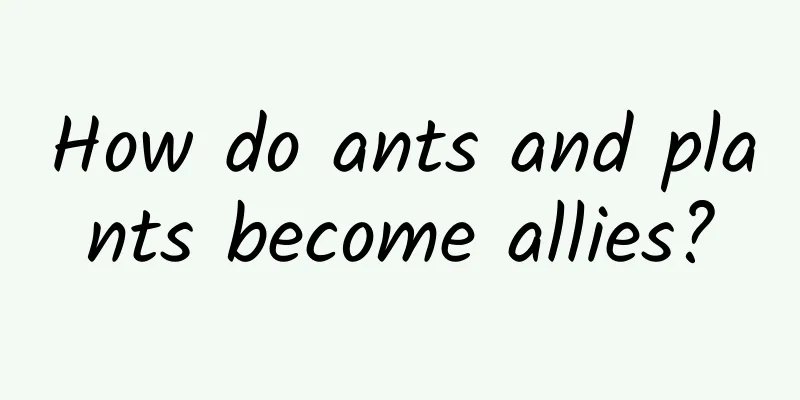How do ants and plants become allies?

|
Produced by: Science Popularization China Author: Qin Yalong (Institute of Botany, Chinese Academy of Sciences, Jiangsu Province, Nanjing Zhongshan Botanical Garden) Producer: China Science Expo Editor's note: In order to decode the latest mysteries of life science, the China Science Popularization Frontier Science Project has launched a series of articles called "New Knowledge of Life" to interpret life phenomena and reveal biological mysteries from a unique perspective. Let us delve into the world of life and explore infinite possibilities. In nature, ants and plants influence and depend on each other. After a long period of evolution, they gradually form a magical mutually beneficial symbiotic relationship. This article uses the symbiotic relationship between ants and plants to scientifically explain how ants and plants co-evolve. The co-evolution of ants and plants began with ants feeding on plants, after which plants evolved structures and habits that were beneficial to ants. Coevolution of ants and angiosperms There are more than 14,000 species of ants on Earth, making them one of the most numerous insects. They and angiosperms originated in the Cretaceous period around 140 million years ago and are now distributed on every continent except Antarctica. In 2023, a study published in Evolution Letters revealed the close relationship between ants and angiosperms (flowering plants) in evolution and diffusion. The study pointed out that from the late Cretaceous to the early Paleogene more than 60 million years ago, as the leaves of angiosperms evolved more stomata, the forest environment on which they depended for survival gradually became moister, and the epiphytes on the trees became more and more abundant. At this time, the ants that originally nested underground in the forest also gradually evolved, giving rise to arboreal ants that nested in trees, reducing interspecies competition through vertical stratification of the community. Plants and ants illustration (Photo source: veer photo gallery) When angiosperms spread out of the forest, ants also spread with them. In the process, angiosperms evolved a variety of food supply methods, such as oleosomes (attached structures on seeds, containing sugars, proteins, and lipids) and extrafloral nectaries (nectaries growing on plant young stems, leaves, pedicels, and other nutritional organs), which may be important factors in the influence of angiosperms on the evolution of ants. Coevolution of ants and plant nectaries Some plants use honeydew as a reward and form a symbiotic relationship with ants. The honeydew we are talking about here is different from the nectar that promotes pollination. It usually refers to the honeydew secreted by the extrafloral nectaries, which can attract ants and resist the grazing of herbivores. According to literature records, extrafloral nectaries are widely present in nearly 4,000 species of flowering plants. Some species of ferns have diverse extrafloral nectaries , which may secrete nectar similar to that of angiosperms, containing monosaccharides, polysaccharides, amino acids, etc. Diverse nectaries of ferns (Image source: Reference 10) The latest research shows that the interaction between plants and herbivores affects the trajectory of evolution. Some plants have evolved indirect defense strategies, bribing ants with honeydew, and the ants that receive the honeydew act as bodyguards for the plants. These ant-attracting nectaries originated in both ferns and angiosperms during the Cretaceous, coinciding with the rise of ant-dwelling plants, and co-evolved in both ferns and angiosperms. When ferns transitioned from the forest floor to the canopy, they again recruited ants from the existing ant-angiosperm system as bodyguards. Among ferns, those that live in symbiosis with ants include Platycerium, Lecanopteris and Microgramma of the Polypodiaceae family. Ants and Staghorn Fern Symbiosis In recent years, Staghorn fern plants have been sought after by more and more plant lovers due to their extremely high ornamental value. The main feature of this genus is the dimorphic leaves, which are divided into nutrient leaves (sterile leaves, humus leaves) and reproductive leaves (fertile leaves, spore leaves). The base of the nutrient leaves is imbricate and often attached to the trunk or branches. Some of the commercial leaves are upward in the shape of a bird's nest, which can receive humus and rain. When the reproductive leaves mature, spores can grow on the back for reproduction. Because they are mostly in the shape of antlers, they are named "staghorn fern". Staghorn fern (Photo credit: Photo taken by the author) Staghorn fern vegetative leaves (Photo credit: Photo taken by the author) Staghorn fern plants that are epiphytic on trees and branches sometimes choose to coexist with ants, such as the Malayan Staghorn fern Platycerium ridleyi Christ. Ants can build nests in its nutrient leaves. The raised veins of the nutrient leaves are like paths for ants to travel. Sometimes holes appear on the surface of the leaves, which may also be passages made by ants to facilitate entry and exit. In return, ants can act as bodyguards, helping the Malayan Staghorn Fern reduce the occurrence of diseases and pests, and can also use the humus produced during feeding and breeding as nutrients for the Malayan Staghorn Fern. Symbiosis between ants and myrmecophaga Ant fern plants have hollow, swollen rhizomes, and the shapes of the rhizomes of different species vary. Their rhizomes are mostly branched, and the protrusions at the top of the branches are called "leaf feet", from which the leaves grow. In the symbiotic system, ants of the genera Iridomyrmex and Crematogaster will make their homes in the enlarged rhizomes of the genus Crematogaster. At this time, the genus Crematogaster no longer tempts the ants with food, but instead provides them with a safe "home". The ants can provide nutrients to the ferns through feces or food residues, and can also act as bodyguards to help the genus Crematogaster resist pests, achieving a win-win situation for both parties. Ant fern rhizome (Image source: PlantSystematics.org) Ants and Pteris symbiosis The symbiotic relationship between the genus Pteris and ants is even more interesting. They do not provide homes for ants directly. The only places ants can live in are old houses left behind by other insects. By studying the ant flora succession induced by Lepidoptera insects in the stem galls of Microgramma squamulosa (Kaulf.) de la Sota, researchers found that the insects parasitizing the stem galls of Microgramma squamulosa (Kaulf.) de la Sota will leave on their own after they mature, leaving holes on the surface of the galls. These galls will be reused as shelters and nesting sites by other insects, and arboreal ants are the main insect species. Among the 49 galls collected in the experiment, a total of 6 species of ants were found to have successfully lived in the second-hand gall homes. Parasitic on the stem gall of Pteris multiscaly Upper left: Stem gall; Upper right: Small lepidopteran gall insect exude gall; Bottom left: Cross-section of a stem gall where ants live. Bottom right: The holes left on the stem gall. (Image source: Reference 9) Therefore, if ants living on these ferns encounter mature spores while feeding on honeydew or defending against pests, they can help these ferns complete the spread of spores. Ants and bacteria symbiosis In the process of mutualistic symbiosis and co-evolution between ants and plants, the diverse associated bacteria in the ant nest also help the ant colony resist adverse conditions such as disease and nitrogen deficiency, which is crucial to the development of the ant colony. Therefore, the symbiosis between ants and bacteria is also considered to be a necessary condition for ants to settle in the canopy of tropical rainforests. Coevolution of ants and plant pollination So far, very few plants have been found to be pollinated by ants, and the role of ant pollination may be underestimated. Most people believe that ants cannot fly in most cases, cannot carry a lot of pollen, and their own secretions reduce pollen vitality, which are all factors that affect the scarcity of ant-pollinated plants. However, we have overlooked the huge size of the ant family and the long-term symbiotic relationship between ants and plants. Some plants may evolve to adapt to ants , but our current research is not deep enough. When we searched for information on ant pollination, the most common ones were orchids, which seemed to be more suitable for ant pollination. We will explain this through several classic ant-orchid pollination cases. In southern Australia, there is a small rabbit orchid, Leporella fimbriata (Lindl.) ASGeorge. When it blooms, the lip of the flower will imitate the appearance of a local female ant, thereby attracting winged male ants to fly and mate with it. During the fake mating process of the male ants, they help the small rabbit orchid to complete pollination. In order to achieve pollination, the geographical distribution of the rabbit orchid and male ants, and the flowering period of the rabbit orchid and the nuptial flight period of the male ants have evolved to be consistent. The rabbit orchid releases specific pheromones during its flowering period and has also evolved a unique flower shape to attract winged male ants. The coordinated evolution of the two has created such a classic ant pollination method. Little Rabbit Orchid (Image source: Seeds of South Australia) Another orchid also distributed in Australia, Microtis parviflora R.Br., has a local wingless worker ant as its effective pollinator, and it may be the only pollinator. During the pollination process, perhaps because the antibiotics secreted by the ants themselves greatly reduce the survival rate of pollen, when these ants carry the orchid pollen, their bodies are connected to the pollen through a short stalk, which prevents the ant's thymus, which secretes antibiotics, from coming into direct contact with the pollen, thus ensuring the success of pollination. Ant pollination of Allium microphyllum P: pollen; St: short stalk; V: sticky disc (Image source: Reference 8) Chinese researchers have found that ants are the main pollinators of the alpine bird's nest orchid Neotia listeroides Lindl. and the variegated orchid Neotia puberula var. maculata (Tang & FTWang) SCChen, SWGale & PJCribb. When they are feeding on nectar in flowers, their head movement will stick to the pollen mass, thus helping the flowers to complete pollination. Interestingly, when the ants stick to the pollen mass, the flower's stamen proboscis (the tongue-like protrusion in front of the orchid column) will immediately move down to cover the stigma, and then rise again after a few hours, effectively preventing pollen from being pollinated on its own stigma and avoiding self-pollination. Alpine bird's nest orchid (Photo source: RangerLantern Wang Hanchen) Although ants also help pollinate Cleisocentron malipoense (ZJLiu & LJChen) R.Rice, which grows in Gaoligong Mountain, is different from alpine bird's nest orchids and variegated leaf orchids. With the help of tree-dwelling ants, Cleisocentron malipoense rarely pollinates with different flowers, and mainly self-pollinates or pollinates with different flowers on the same plant. Xin Qilan (Image source: OrchidRoots) It is an indisputable fact that ants’ own secretions can reduce pollen vitality. During their life activities, ants secrete antibiotics through special glands on their bodies. These antibiotics can be used to treat their own wounds or to inhibit the occurrence of plant diseases such as fungi or pathogens when growing fungi (mushrooms). However, they can destroy pollen grains and cause pollination failure. Ants and bees pollinate the genus Cigarette (Image source: Reference 4) However, after a long period of co-evolution, the pollen of Conospermum plants living in Australia can effectively resist the damage of ant antibiotics, allowing ants and local bees to participate in pollination together, establishing a mutually beneficial symbiotic pollination relationship with ants, and further ensuring the pollination rate. Little girl observing ants (Photo source: veer photo gallery) Summarize Although ants are small, they are an important biological group in nature and play a very important role in the ecosystem. There are still many unsolved mysteries waiting for us to discover and explore the interaction between ants and plants and other organisms. Let us get close to nature, walk into the plants and trees around us, look at all things in nature with a sense of discovery, and explore the beauty and magic of nature. References: 1. Liu Zhongjian, Chen Lijun, Liu Kewei, et al. Chenorchis: a new genus in the Orchidaceae family and its ecological strategy for ant pollination[J]. Acta Ecologica Sinica, 2008, 28(6):12. 2. Wang Chunqiu. Pollination system involving ants: A study on the pollination biology of three orchid species of the genera Orchidaceae and Paraphyllum[J]. Institute of Botany, Chinese Academy of Sciences, 2008. 3.HONOR,GAY.Rhizome structure and evolution in the ant-associated epiphytic fern Lecanopteris Reinw. (Polypodiaceae)[J]. Botanical Journal of the Linnean Society, 1993, 113(2):135-160. 4.Kleber DC , Maura TSH .In search of unusual interactions. A commentary on: Pollen adaptation to ant pollination: a case study from the Proteaceae'[J].Annals of Botany, 2020(3):3. 5.Matthew P. Nelsen, Corrie S. Moreau, C. Kevin Boyce, et al. Macroecological diversification of ants is linked to angiosperm evolution[J]. Evolution Letters, 2023, 7(2), 79-87. 6.Nepel M, Mayer VE, Barrajon-Santos VWD. Bacterial diversity in arboreal ant nesting spaces is linked to colony developmental stage[J]. Communications Biology, 2023, 6(1). 7.Peakall R. The unique pollination of Leporella fimbriata (Orchidaceae): Pollination by pseudocopulating male ants (Myrmecia urens, Formicidae)[J]. Plant Syst. Evol, 1989, 167:137-148. 8.Peakall R, Beattie AJ. Pollination of the orchid Microtis parviflora R. Br. by flightliss worker ants[J]. Functional Ecology, 1989, 3(5):515-522. 9. Santos MG, Porto GF, Lancellotti IR, et al. Ant fauna associated with Microgramma squamulosa (Kaulf.) de la Sota (Polypodiaceae) fern galls[J]. Revista Brasileira de Entomologia, 2019, 63(2). 10.Suissa JS, Li FW, Moreau CS. Convergent evolution of fern nectaries facilitated independent recruitment of ant-bodyguards from flowering plants[J]. Nature Communications, 2024, 15(1). |
<<: A huge flare! What are the effects? →
Recommend
My vision is only 0.1! I can’t use this kind of eye drops!
Review expert: Peng Guoqiu, deputy chief physicia...
How to break the offline defeat of new consumer brands?
In the past two years, some consumer brands targe...
Analysis of NetEase Cloud’s operational logic!
Let me make a bold prediction. I feel that a new ...
Are you prone to allergies in spring? Preventing eczema is the key
As the temperature gradually rises Many friends c...
The Lancet: The higher the education level, the lower the risk of death
This week's noteworthy scientific research Na...
18 most classic user growth operation cases on the Internet
Part 1: Growth Hacking and Related Concepts 1. Gr...
Can the geese and ducks in "Goose and Duck Killing" fart? Goose & Duck: We don't fart at all
If we talk about the most popular games this mont...
China Passenger Car Association: In February 2025, the retail sales volume of the domestic narrow passenger car market was 1.382 million units, a year-on-year increase of 25.6%
According to recent news, the China Passenger Car...
Zhu Dan's Basic Sketching Course [General Quality]
Table of contents: 02 How to draw the folds of cl...
Who controls the fate of Didi Chuxing?
A turbulent undercurrent set off by "Didi Pr...
Why do some people burp smell? It may be because they haven't farted yet.
I finally squeezed into the elevator A burst of &...
This app can make the iPhone X's bangs disappear
The much-anticipated iPhone X has begun shipping....
How to create a differentiated brand image and make the industry leader unable to fight back?
-1- If you become number one in a small market, t...
Play user behavior path analysis, 3 methods are enough
This article will introduce three commonly used a...
Wudalianchi SEO training: What are the factors that affect the website bounce rate?
If a website has a high bounce rate, it means tha...









